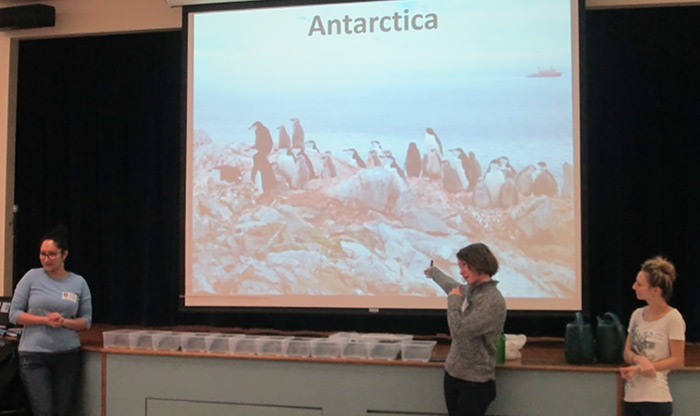Lesson Taught Students about Climate Change
In February, three Department of Earth and Atmospheric Sciences graduate students, Yuribia Muñoz, Delaney Robinson and Alicia Staszyc, volunteered at Roberts Elementary, near the Texas Medical Center. They taught 120 fourth graders, as well as their teachers and some parents, about climate change impacts on sea level.
 EAS students (left to right) Yuribia Muñoz, Alicia Staszyc and Delaney Robinson present to students at Roberts Elementary about Antarctica and climate change. (Photo courtesy of teacher Jennifer Heemer)The three EAS student volunteers are studying the sedimentary record of glacial history in Antarctica for their research projects. At Roberts, they first focused on explaining the environment in Antarctica and how susceptible it is to change under warming temperatures. After the EAS volunteers presented photos of their own experiences studying Antarctica, the students showed an interest and asked a variety of insightful questions.
EAS students (left to right) Yuribia Muñoz, Alicia Staszyc and Delaney Robinson present to students at Roberts Elementary about Antarctica and climate change. (Photo courtesy of teacher Jennifer Heemer)The three EAS student volunteers are studying the sedimentary record of glacial history in Antarctica for their research projects. At Roberts, they first focused on explaining the environment in Antarctica and how susceptible it is to change under warming temperatures. After the EAS volunteers presented photos of their own experiences studying Antarctica, the students showed an interest and asked a variety of insightful questions.
Following the presentation, the elementary students participated in two hands-on experiments. The first included a simulation to show the difference in the effect on sea level from ice on land melting compared to melting ice that is already in water.
The fourth graders were able to see that the water rose only if ice was melting from land. However, when their individual ice cube was placed directly in the water, the students were amazed to see that the water level did not rise as the ice melted. The EAS students explained to them that when ice already floating in the ocean melts, it does not contribute to sea-level rise. On the other hand, when the warming climate melts ice grounded on land, which in turn transports water to the ocean, sea level will rise.
The second activity involved showing the students how geologists can look back in time through examining depositional layers in a sedimentary core. The EAS students gave different colors of clay to the fourth graders to flatten into separate sheets. They then stacked these clay layers to represent the deposition of alternating glacial and marine sediments through time. The layers were sliced in half to exhibit the vertical succession that geologists use to reconstruct earth’s history.
The students at Roberts Elementary were interested in what the EAS department’s Antarctic geologists study and how it pertains to a change in earth’s environment over time, especially on rising seas and the potential impact on the Texas shoreline.
- Delaney Robinson and Alicia Staszyc